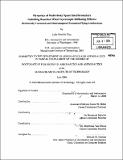Dynamics of multi-body space interferometers including reaction wheel gyroscopic stiffening effects : structurally connected and electromagnetic formation of flying architectures
Author(s)
Elias, Laila Mireille, 1977-
DownloadFull printable version (20.99Mb)
Other Contributors
Massachusetts Institute of Technology. Dept. of Aeronautics and Astronautics.
Advisor
David W. Miller.
Terms of use
Metadata
Show full item recordAbstract
Space telescopes have the potential to revolutionize astronomy and our search for life-supporting planets beyond our Solar System. Free of atmospheric distortions, they are able to provide a much "clearer" view of the universe than ground-based telescopes. A developing technology that appears promising is space-based interferometry, which uses multiple apertures separated at great distances to act as a large virtual aperture. In this way, interferometers will achieve angular resolutions far greater than those achievable by monolithic telescopes. In this thesis, we investigate the dynamics and control of two proposed architectures for spaceborne interferometers: structurally connected interferometers and electromagnetic formation flying interferometers. For structurally connected interferometers, we develop a coupled disturbance analysis method that accurately predicts a space telescope's optical performance in the presence of reaction wheel vibrational disturbances. This method "couples" a reaction wheel to a structure using estimates of the accelerances (or mobilities) of both bodies. This coupled analysis method is validated on the Micro-Precision Interferometer testbed at NASA's Jet Propulsion Laboratory. The predictions show great improvement over a simplified "decoupled" analysis method when compared to experimental data. For formation flying interferometers, we consider the use of electromagnets as relative position actuators. A high fidelity, nonlinear dynamic model of a deep-space electromagnetic formation flight (EMFF) array is derived from first principles. The nonlinear dynamics are linearized for a two-vehicle array about a nominal trajectory, and the linearzed model is shown to be unstable, (cont.) but controllable, and therefore stabilizable. A linear optimal controller is designed for the system and implemented to form the closed-loop dynamics. Time simulations of the closed-loop nonlinear dynamics demonstrate that EMFF using linear control proves very effective, despite the nonlinearities of the system's dynamics and the electromagnetic actuators.
Description
Thesis (Ph. D.)--Massachusetts Institute of Technology, Dept. of Aeronautics and Astronautics, 2004. Includes bibliographical references (p. 181-184).
Date issued
2004Department
Massachusetts Institute of Technology. Department of Aeronautics and AstronauticsPublisher
Massachusetts Institute of Technology
Keywords
Aeronautics and Astronautics.